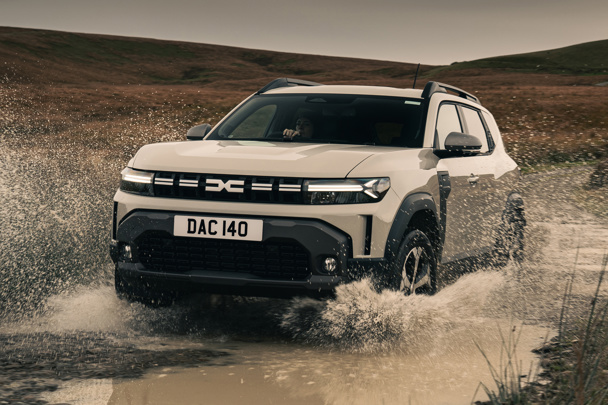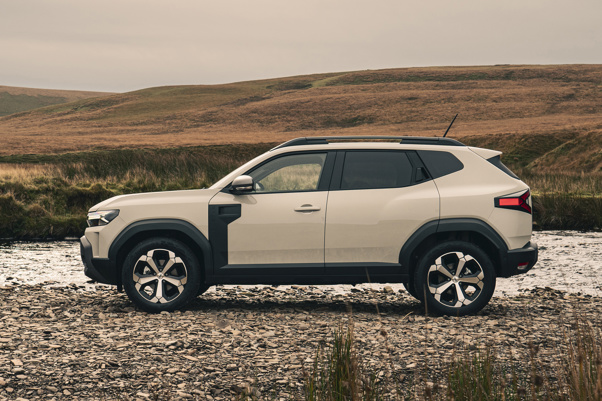Dacia Duster Review 2025
Dacia Duster At A Glance
There’s a significant number of car buyers who, despite cars becoming evermore technically advanced, prefer the notion of rugged simplicity, wrapped in small SUV convenience that champions practicality over premium features. The Duster's predecessors have successfully sated those customers’ needs, so read our comprehensive review of latest generation of Dacia Duster to see how it fares on that score.
Introduced in 2024, the latest generation of Dacia Duster represents a further refinement of an already impressive and popular car. It’s now more efficient and smarter-looking, but still maintains its budget appeal.
Because it seems almost every manufacturer is clambering to grab a slice of the compact SUV pie, the Dacia Duster has a greater number of rivals than ever before, which means it also has to appeal to buyers considering one of those alternatives as well as its loyal fanbase.
The addition of a Dacia Duster hybrid SUV option brings it more up to date in a market barrelling towards electrification, and that's in addition to the mild-hybrid petrol and petrol-LPG Bi-Fuel alternatives. Four-wheel drive remains available with the mild-hybrid petrol engine, although diesels don’t feature this time around.
Sat inside the Dacia Duster, the experience depends on which model you pick. The (now-defunct) entry-level car merely has a cradle to hold your smartphone - and that's pretty much it for infotainment - but all other versions have a 10.0-inch multimedia touchscreen and a digital instrument panel.
Sure, some of the Duster's tech and materials feel sub-par compared with higher-price rivals, but the Duster remains true to its roots as a non-nonsense, practical SUV that appeals to those valuing function over form, with plenty of room for passengers and their luggage. Plus the all-wheel-drive 4x4 models are surprisingly capable off-road.
The latest Dacia Duster is a sound small family SUV choice, made even more appealing by its low price and improved tech. And if you’re thinking that for your growing family you now need something larger, you can have it in the form of the Dacia Bigster.
Dacia Duster handling and engines
Dacia Duster 2025: Handling and ride quality
The Duster’s ride quality is very reasonable, especially for a car at this price point. It’s not particularly sophisticated and can struggle with larger potholes, but it absorbs most bumps and imperfections well enough around town and in the countryside. It’s soft enough to be comfortable, but not so floaty that it feels disconnected from the road.
The handling is also fine: not great, not terrible, but fine. It’s an improvement on the previous-generation Dacia Duster's, and while there’s body roll in the corners and a lack of feedback through the steering, it’s entirely acceptable for everyday driving. You won’t feel the urge to press on down a country road, but getting from A to B will cause no issues.
As well as front-wheel-drive models, the Dacia Duster can be specced in 4x4 form, which gives you an all-wheel-drive system that engages the rear wheels when the fronts become overwhelmed and start to slip. There’s also the option to switch between different off-road modes depending upon the surface underneath the car.
We tested one on an off-road course and it was evidently capable of handling far tougher terrain than we experienced. While it’s no bargain-priced Land Rover Defender alternative, it’ll easily cope with muddy fields and farm tracks.

Dacia Duster 2025: Engines
This generation of Dacia Duster has been offered with a range of three engines, although none of them are diesels.
Kicking the range off was a three-cylinder, 1.0-litre petrol and LPG engine in the Duster TCe 100 Bi-Fuel. It produced 100hp regardless of the fuel used, although torque output dropped to 160Nm from 170Nm when running on petrol.
This has a knock-on effect performance-wise as its 14.1-second 0-62mph time can be trimmed to 13.2 seconds when running on LPG (Liquid Petroleum Gas). In truth , the TCe 100 BiFuel is hard to recommend: yes, LPG is cheaper than petrol, but LPG pumps are rapidly disappearing from filling stations in the UK. Not that new-car buyer have to worry about that: this entry-level engine was only available in entry-level Essential trim, and now that this trim level has been dropped from the range, so has the engine.
Our pick of what's left is the three-cylinder, 1.2-litre mild hybrid-equipped Duster TCe 130, with enough grunt to make reasonable progress, plus it has a more affordable purchase price than the full hybrid, yet still delivers reasonable fuel economy.
It develops 130PS and 230Nm of torque, which gives a 0-62mph time of 9.9 seconds for the front-wheel drive version and 11.0 seconds for the 4x4. Just be aware that it’s rather noisy and the six-speed manual gearbox is nothing to write home about, but it does the job.
New for the this generation is the four-cylinder 1.6-litre Duster Hybrid 140, which has slightly more power at 140PS and is noticeably smoother. However, it’s more expensive that the 130PS engine and the fuel economy benefits are minimal. Its six-speed automatic gearbox isn’t brilliant, either, and has a tendency to hang in a high gear for too long when left to its own devices.
Dacia Duster 2025: Safety
Somewhat controversially, the Dacia Duster’s been designed to deliberately avoid some of the key benchmarks set out by independent safety organisation Euro NCAP, saying that customers don’t want to pay over the odds for unnecessary safety systems.
As a result, the Duster scored only three out of five stars in the Euro NCAP tests, mainly because of a lack of advanced driver assistance technologies. Only those required by law are present, such as automatic emergency braking.
If you do prioritise active safety systems, then rivals such as the Skoda Kamiq may offer better peace of mind, but there’s a strong argument to be made that the Duster’s safety equipment is adequate for most day-to-day driving scenarios.
Dacia Duster 2025: Towing
If you’re planning on using your Dacia Duster as a towing vehicle, you may wish to reconsider, especially with no diesel versions in the range, the go-to fuel choice for owners of earlier models with caravans.
Braked towing capacity for the TCe 100 Bi-Fuel is 1200kg, improving up to 1500kg with the TCe 130 engine, regardless of how many driven wheels it has. And the Hybrid 140? A disappointing 750kg maximum.
Dacia Duster interior
Dacia Duster 2025: Practicality
The Dacia Duster offers reasonable space in both the front and rear, with comfortable seats and decent visibility. Access is easy thanks to the high ride height, and the rear doors open easily wide enough to get child seats in and out. Headroom in the back is very generous, although three adults side-by-side will feel squeezed.
The boot space is generous, although it varies by model. If you want the maximum cargo capacity, go for the front-wheel-drive TCe 130 model without a spare wheel, as that gives you 517 litres of space. Adding a spare wheel drops that to 464 litres, while the additional mechanical components of the 4x4 version limit it to a 456-litre capacity.
Opt for the TCe 100 Bi-Fuel model, and the space taken away by its extra fuel tank drops boot capacity to 453 litres. The Hybrid 140 has even less space: 430 litres with no spare wheel, or just 400 litres with one.
Fold down the back seats — which are split 60:40 but don’t quite lie completely flat — and the boot space opens up to between 1545 litres and 1609 litres, depending on the model.
Dacia is very keen to stress the Duster’s outdoorsiness, meaning you can even order a bed accessory that’s designed to go over the folded back seats for camping.

Dacia Duster 2025: Quality and finish
The quality of the Dacia Duster won’t blow anyone’s socks off, but any criticism has to be tempered by remembering how affordable it is. There are no issues with how everything is bolted together — the cabin feels solid and largely rattle-free — but soft-touch materials are conspicuous by their absence and all the plastics feel rather hard and utilitarian.
In fairness, the tough, no-nonsense feel is part of the Duster’s vibe, so it’s difficult to be too harsh on it, but it’s not as plush as something like a Skoda Kamiq.
There are, it should be said, some nice design elements, especially in the higher trims, such as the Y-shaped patterns in the headlights that are mirrored on the interior air vents.
Dacia Duster 2025: Infotainment
Opt for the entry-level (and now-discontinued) Dacia Duster Essential and the infotainment system is… Well, it’s your smartphone. Literally.
There’s a holder mounted into the dashboard, into which you pop your phone and use its screen for navigation and entertainment needs. A small 3.5-inch display in the otherwise analogue instrument panel is its only real concession to modernity.
With all other trims, however, you get a much more up-to-date 10.0-inch multimedia touchscreen that features Apple CarPlay, Android Auto and, for Journey and Extreme versions, integrated navigation.
The system is user-friendly enough with simple menus, although it’s not the fastest in terms of response, and lacks the wireless connectivity that some rivals can offer. There’s a six-speaker Arkamys sound system on higher-spec models, which sounds pretty good.
Dacia Duster value for money
Dacia Duster 2025: Prices
The Dacia Duster looked exceptionally cheap when it first went on sale: prices started at less than £19,000 for the entry-level Essential TCe 100 Bi-Fuel, and rose to just under £27,000 for the top-spec Extreme Hybrid 140 model.
These days, the prices don't look quite so dazzling as they once did. Both the entry-level trim and the entry-level engine have since been dropped from the range, and this has hiked the starting price up to around £22,000. Prices for the remaining versions have also risen by a few hundred quid across the board, but nevertheless, the Duster still looks like fantastic value for money when compared with competitors.
The latest Duster is still new enough that the used car market isn't exactly flooded with pre-owned examples, and Dacias tend to have quite strong residual values due to how little they cost in the first place. As such, used prices haven't had a chance to come down by too much just yet, but you'll still make a handy four-figure saving, version-for-version, if you opt for a year-old example instead of a brand new one.

Dacia Duster 2025: Running Costs
The straightforward engine range should ensure that the Dacia Duster remains affordable to run. In front-wheel drive form, the TCe 130 petrol engine returns up to 51.3mpg according to official figures, while the Hybrid 140 version promises up to 55.3mpg: better, although not by loads, considering its far higher price tag (around three grand higher).
All-wheel drive trims the TCe 130’s efficiency down to around 46mpg but it’s the cheapest (and now-discontinued) TCe 100 Bi-Fuel that’s the thirstiest of all. Around 43mpg when running on petrol isn’t dazzling, yet 35mpg while using LPG is decidedly underwhelming.
Insurance groups range from 17 to 25 (of 50), which should ensure that premiums are reasonable.
The Duster's low pricing means that no version will have to worry about the luxury car surcharge being added to their annual VED road tax bill, leaving buyers with just the £195-per-year flat rate to pay.
Satisfaction Index
 What is your car like to live with?
What is your car like to live with?
We need your help with our latest Satisfaction Index, so that we can help others make a smarter car buying decision. What's it like to live with your car? Love it? Loath it? We want to know. Let us know about your car - it will only take a few minutes and you could be helping thousands of others.
Help us with the Honest John Satisfaction Index nowDacia Duster models and specs
When it first went on sale, the latest Dacia Duster was available in four trim levels: Essential, Expression, Journey and Extreme. Those top two are split, with one being more comfort and road-focused, with the other having a more rough, tough, off-roading character.
The range started with the bare-bones Dacia Duster Essential, which has:
- 16-inch steel wheels
- body coloured bumpers
- automatic LED headlights
- cloth seats
- manual air conditioning
- roof bars
- cruise control
- rear parking sensors
- electric front windows
- smartphone holder on the dashboard
- DAB radio with four speakers
Next up is the Dacia Duster Expression, which comes with:
- 17-inch diamond-cut alloy wheels
- denim upholstery
- infotainment system with a 10-inch touchscreen
- rain-sensing wipers
- foldable key
- electric rear windows
- five YouClip attachment points
- rear-view camera
- hill descent control (4x4 versions only)
Upgrade to a top-spec model and you have two choices. The more on-road-focused model is the Dacia Duster Journey, which has:
- 18-inch alloy wheels
- front fog lights
- automatic air conditioning
- keyless entry
- electric parking brake
- wireless phone charger
- 10.1-inch infotainment system with navigation
- Apple CarPlay and Android Auto
- front parking sensors
- multiview camera system
- blind-spot warning system
The Dacia Duster Extreme model meanwhile, is more off-road oriented and has:
- all-season tyres
- copper-coloured door mirror shells
- modular roof bars
- rubber mats
- centre console with an armrest
- extra storage
- washable inserts in the doors
- plastic-coated upholstery
- heated seats
- heated steering wheel
- wireless phone charger
Since the initial launch, however, the entry-level Essential trim has been dropped from the range, which has obviously elevated the starting price of the car.
Model History
September 2025
Dacia Duster gets upgraded powertrains
Following their introduction on the new Bigster, Dacia has announced improved powertrains for the Duster. The revised models will go on sale in November 2025 and prices will be announced then.
The hybrid 155 replaces the hybrid 140 model, and combines a 110PS petrol engine with a 50PS electric motor and a high-voltage starter/generator), a 1.4kWh battery and a four-speed automatic gearbox.
This gives the hybrid 155 an eight per cent improvement in fuel economy and cuts CO2 emissions to 105g/km, or seven fewer compared with the hybrid 140.
The Duster mild hybrid 140 replaces the mild hybrid 130 and gets a new 1.2 litre three-cylinder petrol engine combined with a 48V mild hybrid system and a six-speed manual gearbox, improving fuel economy by 10%.
To coincide with the new powertrains, Dacia has updated the upholstery on the Journey trim level and Extreme models get new 18-inch black alloys. Adaptive cruise control is standard on hybrid versions of the Extreme and Journey trims.












 Rugged styling. Spacious interior. Great value for money.
Rugged styling. Spacious interior. Great value for money.
 Cheap interior plastics. Sluggish infotainment system. Hybrid offers only limited fuel savings.
Cheap interior plastics. Sluggish infotainment system. Hybrid offers only limited fuel savings.






